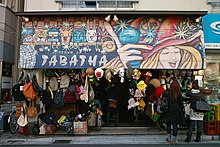Shimokitazawa



Shimokitazawa (下北沢, Shimokitazawa) is a commercial and entertainment district in Setagaya, Tokyo. Also known as "Shimokita", the neighbourhood is well known for the density of small independent fashion retailers, cafes, theaters, bars and live music venues.
Independent retail
The neighbourhood is often compared with the backstreets of Ura-Harajuku and Koenji; smaller shop units and restricted vehicular access has limited its appeal to larger domestic and international fashion merchandisers, enabling independent retailers to survive. The district consists of the streets immediately surrounding Shimo-Kitazawa Station, where the Odakyu Electric Railway and Keio Inokashira Lines intersect. The neighbourhood has long been a center for stage theater and live music venues; serves as a home to the historic Honda Gekijō theater and holds theatre festivals throughout the year. With numerous cafes, secondhand and vintage fashion and recorded music outlets, Shimokitazawa remains popular with students and followers of Japanese youth subcultures.[1]
Redevelopment
In 2004, the Setagaya City Council released a plan to redevelop a large section of the city, including the construction of several high rise buildings, and extending Route 54 across the city. The streets are very narrow and highly intersected, with many small alleyways. Because many residents and visitors consider this to be part of the charm of Shimokitazawa, some controversy surrounds the development plan.[2][3]
With the relocation of the Odakyu Line rail tracks underground in March 2013, larger scale redevelopment of the immediate Shimo-Kitazawa Station area is ongoing.
References
- ^ Kawamura, Yuniya (2012). Fashioning Japanese Subcultures. Berg Publishers / Bloomsbury. p. 93. ISBN 9780857852151.
- ^ Save the Shimokitazawa
- ^ "Splitting a Hip Neighborhood, in More Ways Than One" by Martin Fackler, The New York Times, October 1, 2006.
External links
 Media related to Shimokitazawa at Wikimedia Commons
Media related to Shimokitazawa at Wikimedia Commons- Shimokitazawa (JNTO)
- Go Tokyo Travel Guide
- Shimokitazawa Music Festival (Japanese)
